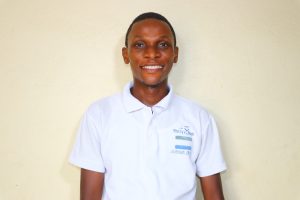A water crisis affects the health and unity of the Royeama Community, which has 200 residents. Although they have access to a well, it is seasonally dry and often overcrowded. Their only other option is a swamp that continually makes them sick.

Collecting water from the swamp.
"The location of this water point makes them suffer to fetch and transport water. One must climb the hill to fetch water. It is difficult to walk carrying a bucket of water on your head. The slightest mistake, a person can injure him/herself because the road is slippery," shared Field Officer Julius Sesay.

Making the journey to collect water.
"Frequent climbing of the hill to fetch water from the well has caused most water users to suffer from severe back pain. Others have even sustained injuries, especially when they fell from the hill. This occurs when the place becomes slippery. Overcrowding at the water point has created some forms of quarrels and drinking buckets to be stolen. Similarly, the church service gets disrupted as some of the church members will leave the service just to go in search of water for drinking. This mainly occurs during the dry season when the sources they fetch water from become dry or when the well breaks down," he added.
Like so many young women in Sierra Leone, Salamatu bears heavy burdens for one so young. She is responsible for collecting water for her family's needs, a task that is not simple or safe.

Salamatu.
"I feel discouraged each time I am sent to fetch water. This is because the constraints faced in fetching water are too much," she said.
"The walking distance and waiting time at the well cause the delay. There is no other water well around this community apart from this well. That is why it is very difficult to fetch water from this source because of the demand for water. The number of water users increases with time. The number of buckets and five-gallon rubbers you will meet at the well during the morning hours will be great. This even discourages me from fetching water from this source. Most times, the well will be restricted from us. Especially when they need water to clean the mosque, perform ablution, drink, etc. This situation forces me to wait until they are through or divert my way to the swamp to fetch water. This is also a distance away from our house," shared Salamatu, 17.
Time isn't the only thing stolen from Salamatu; in her current situation, there is little peace. She worries about her safety and about conflict between community members.
"Safety becomes a concern when the risk of getting injured is common. Therefore, I am worried about safety at our current water source because people have sustained injuries. I remember one of my friends was rushed to the hospital because of a fight. They fought with another person due to a misunderstanding at the well. Even though he later recovered from the injury he sustained. Yet, places like that do not guarantee safety because overcrowding at [the] well can easily lead to quarrels. Not everybody will be able to exercise patience to wait for their turn," she said.

"In the same way, the hill is a big risk. I have fallen from this hill countless times because the place was slippery. I ended up returning home with a broken rubber bucket," continued Salamatu.
The water crisis in the Royeama Community has devastating effects on their safety and health. Both water sources make the people sick, leading to illnesses such as typhoid, diarrhea, and cholera. These illnesses make it difficult for them to work or attend school, making progress nearly impossible.
"Having a new well will help me to fetch water easily. No need to queue to fetch water from the mosque. This will avert all forms of quarrels and fighting and help me to be safe. Also, I will no longer climb the hill to fetch water. This also will help me to fetch water safely," shared Salamatu.

Salamatu collecting water.
Installing a well in the community will provide Salamatu with the time to focus on her education and gather water without hassle. Access to clean water will provide her with the resources she needs to work towards a bright future. She dreams of becoming an engineer, a goal that can only be realized once her basic needs are fulfilled.
Steps Toward a Solution
Our technical experts worked with the local community to identify the most effective solution to their water crisis. They decided to drill a borehole well, construct a platform for the well, and attach a hand pump.
Well
Abundant water often lies just beneath our feet. Aquifers—natural underground rivers—flow through layers of sediment and rock, offering a constant supply of safe water. A borehole well is drilled deep into the earth to access this naturally filtered and protected water. We penetrate meters, sometimes even hundreds of meters, of soil, silt, rock, and more to reach the water underground. Once found, we construct a platform for the well and attach a hand pump. The community gains a safe, enclosed water source capable of providing approximately five gallons of water per minute. Learn more here!
Community Education & Ownership
Hygiene and sanitation training are integral to our water projects. Training is tailored to each community's specific needs and includes key topics such as proper water handling, improved hygiene practices, disease transmission prevention, and care of the new water point. Safe water and improved hygiene habits foster a healthier future for everyone in the community. Encouraged and supported by the guidance of our team, a water user committee representative of the community's diverse members assumes responsibility for maintaining the water point, often gathering fees to ensure its upkeep.

 Borehole Well and Hand Pump
Borehole Well and Hand Pump
 Rehabilitation Project
Rehabilitation Project
















